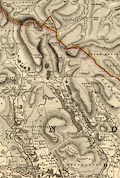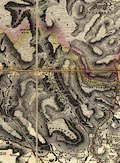


Greenwood and Hodgson, Westmorland Gazette 1823
Transcripts of advertisements and letters in the Westmorland Gazette and the Kendal Chronicle, a controversy between C Greenwood and T Hodgson, surveyors of Westmorland maps, 1823.
source type: Westmorland Gazette 1823
source type: Kendal Chronicle 1823
The newspaper titles are the Westmorland Gazette and Kendal Advertiser, referred to as the Westmorland Gazette, and the Westmorland Advertiser and Kendal Chronicle, referred to as the Kendal Chronicle. The correspondence mostly proceeds in parallel in both newspapers, though there are parts in one or the other not in the other or one.
Transcription
The transcripts are made from microfiche images, of variable legibility, of an incomplete series of newspapers; and from old photocopies of newscuttings found in the library files, also of variable legibility, which include copies of more newspapers than survive in microfiche. Where the photocopy is the only version there is no clue where the letter appeared in the newspaper, nor what order letters appeared in one issue - though this is irrelevant, a letter in an issue cannot be a response to a letter in the same issue. The articles appearing in both the newspapers are almost exactly the same, with minor differences of typesetting.
The articles common to both newspapers are transcribed mostly from the Westmorland Gazetter, perhaps with illegible bits filled in from the Kendal Chronicle, always indicated by square brackets [ ] for inferred data. Italics are abandoned; hyphenation is closed up where possible.
Argument, and Libel?
The matter transcribed is sometimes an advertisement, and sometimes a letter perhaps appearing as an advertisement, which had to be paid for. An issue of the newspaper might include more than one letter, which confuses the sequence of the arguments; the response to last weeks letter might be later on a page than a new letter in this weeks. The arguments themselves are confused by the rhetoric of the writers. The tone of writing seems near to libel, but the possibility of going to law over libel is rarely raised, sometimes just in veiled threats.
An added problem of evidence is that neither surveyor wants to upset an individual subscriber by mentioning their name. How much can anything be believed in this lively debate?
Summary
An attempt has been made to see the content of each letter, free of the rhetoric and bombast. Several themes have been identified, and comments made on them for each letter:-
The Maps

 T Hodgson 95; C Greenwood 66; possible score 115
T Hodgson 95; C Greenwood 66; possible score 115
The minutiae on Thomas Hodgson's map win, and are not explained by his marginally larger scale, there is plenty of room on both maps for more. Thomas Hodgson's engraving of hill hachuring is less obtrusive, obscures less of other features and labels. The map images are:-


Hodgson 1828


Greenwood 1824

 Greenwood and Hodgson, Westmorland Gazette
1823
Greenwood and Hodgson, Westmorland Gazette
1823